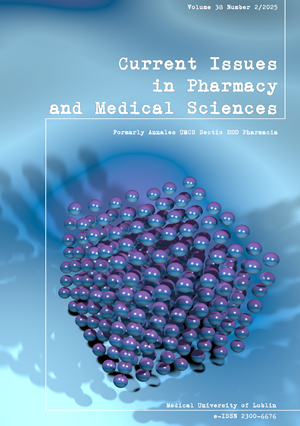Topical use of Cannabis Sativa L. - based emulsion for management of atopic dermatitis persisting from infancy in a 23 year-old male – a case study
DOI:
https://doi.org/10.12923/cipms-2025-0013Słowa kluczowe:
atopic dermatitis, xerosis, hemp oilAbstrakt
In today’s industrialized and quickly developing world, the prevalence of atopic dermatitis in children and adults alike continues to grow. Epidemiological studies conducted over the past 35 years indicate a 2-fold rise in incidence, linked to environmental factors, among others, growing atmospheric pollution, rising socioeconomic status and increasing popularity of the so called western lifestyle. Emollient therapy is the mainstay of proper skincare and treatment for atopic dermatitis (AD) patients.
Our experimental (interventional) study was conducted from June to October. The subject of the study was transdermal delivery of an emulsion compounded with cholesterol ointment, Cannabis Sativa L. (hemp) seed oil, white petroleum jelly, purified water and urea to the skin of hands of a 23-year old male patient suffering atopic dermatitis (eczema) since infancy. The emulsion was applied to the skin once daily before sleep and covered with cotton gloves for the night for the occlusion effect for a period of 3 months.
In our observational study, regular, 3-month application of the emulsion based on Cannabis Sativa L. oil considerably reduced inflammation, erythema, pruritus, xerosis and scaling of the skin, soothing excoriations and lichenification.
Bibliografia
1. Gliński W. Atopowe zapalenie skóry. In: Choroby wewnętrzne. Stan wiedzy na rok 2010. Kraków: Medycyna Praktyczna; 2010:1884-9.
2. Pawliczak R. Nomenklatura atopowego zapalenia skóry. In: Atopowe zapalenie skóry. J. Narbutt, R. Pawliczak (ed). Poznań: Wydawnictwo Termedia; 2019:23-30; 37-50.
3. Teresiak-Mikołajczak E. Epidemiologia. In: W. Silny (ed). Atopowe zapalenie skóry. Poznań: Wydawnictwo Medyczne Termedia; 2012:11-27.
4. Czarnecka-Operacz M. Cyclosporine A in the treatment of patient with atopic dermatitis. Wiad. Derm. 2020;3(18):45-53.
5. Czarnecka-Operacz M. New possibilities in the contemporary topical treatment of inflammatory skin diseases. Wiad Derm. 2019;2(13):10-6; 34-41.
6. Furter S, Jasch KCh. Atopowe zapalenie skóry. In: S. Majewski (ed). Dermatologia. Crash Course. Wrocław: Elsevier Urban & Partner; 2010:91-4.
7. Jaworek KA, Jaworek M, Hałubiec P, Kurzawa R, Wojas-Pelc A. Emolient therapy in children with atopic dermatitis – a pilot study. Pol J Allergol. 2020;7(2):106-15. https://doi.org/10.5114/pja.2020.96131
8. Kamińska E. The role of emollients in atopic dermatitis in children. Dev Period Med. 2018:XXI(4).
9. Kasznia-Kocot, J, Reichmann K, Wypych-Ślusarska A. Selected aspects of quality of life in atopic dermatitis. Env Med. 2014;17(2):42-51.
10. Marcinkiewicz M. AZS – leczenie, suplementacja, pielegnacja. Farm Prakt. 2016;4(95):23-4.
11. Mazur M. The latest treatment quidelines fot AD (2019). Wiad Derm. 2020;3(18):17-22.
12. Millan M, Mijas J. Atopic dermatitis – patomechanism, diagnostics, therapeutic guidelines and prophylaxis. Nowa Pediatr. 2017;21(4):114-22.
13. Trzeciak M, Zaryczańska A. Treatment of atopic dermatitis. Wiad Derm. 2021;1(19):6-18.
14. Brucka-Stempkowska A. Atopic dermatitis – differentia diagnosis of the skin lesions Alerg Astma Immunol. 2009;14(4):223-9.
15. Tuszyński P, Żmudzka E, Polak Ż. Atopowe zapalenie skóry. In: P. Tuszyński (ed). Problemy dermatologiczne. Opieka farmaceutyczna, zasady rozpoznania i leczenia, przegląd leków i kosmetyków. Kraków: Wydawnictwo Farmaceutyczne; 2021:163-80.
16. Nowicki RJ, Trzeciak M, Kaczmarski M, Wilkowska A, Czarnecka-Operacz M. Atopic dermatitis. Interdisciplinary diagnostic and therapeutic recommendations of the Polish Dermatological Society, Polish Society of Allergology, Polish Pediatric Society and Polish Society of Family Medicine. Part I. Prophylaxis, topical treatment and phototherapy. Pol J Allergol. 2019:6,3:69-80.
17. Trzeciak M. Bacterial superinfections in the course of inflammatory skin diseases – do we have an optimal choice of therapy? Wiad Derm. 2019;2(13):17-24.
18. Zalewska-Janowska A. Choroby alergiczne skóry – atopowe zapalenie skóry (cz.3). Psycho/neuro/endokryno/immunologiczne aspekty AZS w gabinecie lekarskim. Dermatol po Dypl. 2022;1:46-50.
19. Avena – Woods C. Overview of atopic dermatitis. Am J Manag Care. 2017;23(8 Suppl):115-23.
20. Godziątkowski H. Ile kosztuje AZS? Wydawnictwo PTCA Atopia; 2020:5-7.
21. Kołodziejczak A. Skóra sucha i atopowa. In: A. Kołodziejczak. Kosmetologia. Warszawa: Wydawnictwo Lekarskie PZWL; 2020:114-20.
22. Michalska DA. Atopowe zapalenie skóry w ujęciu dermatologicznym i kosmetologicznym. Probl Nauk Med Nauk o Zdrow. 2019;10:33-41.
23. Burczyk D. Zastosowanie oleju konopnego w wybranych dermatozach. Rzeszów: Praca dyplomowa magisterska. Wydział Medyczny. Wyższa Szkoła Informatyki i Zarządzania z Siedzibą w Rzeszowie; 2017:29-48.
24. Caputa J, Nikiel-Loranc A. The use of hemp seed oil in cosmetology. Aesth Cosmetol Med. 2019;10(6):461-3.
25. Glinka R, Glinka M. Receptura kosmetyczna z elementami kosmetologii. Wydawnictwo Oficyna Wydawnicza MA; 2008:189-190.
26. Bułaś L. Apteka jako placówka ochrony zdrowia publicznego. In: R. Jachowicz (ed). Receptura apteczna. Warszawa: Wydawnictwo lekarskie PZWL; 2017:6-7.
27. Farmakopea Polska. Tom 1.2022(XII).
28. Jurkowska J. Leki recepturowe w aptece. Wydawnictwo Polskiego Towarzystwa Chorób Atopowych Atopia; 2021:35-8.
29. Sircus M. Lecznicza marihuana. Uzdrawiające właściwości oleju z konopi indyjskiej. Kraków: M Wydawnictwo; 2017:119-20.
30. Simonsohn B. Konopie cud natury. Zdrowotne zastosowanie nasion i oleju konopnego. Białystok: Wydawnictwo Vital; 2016:76-7.
31. Rogoowska-Szadkowska D. Medyczna marihuana historia hipokryzji. Wydawnictwo Krytyki Politycznej; 2016:148-149.
32. Szepietowski J, Szepietowski T, Reich A. Efficacy and tolerance of the cream containing structured physiological lipids with endocannabinoids in the treatment of uremic pruritus: a preliminary study. Acta Dermatovener Cr. 2005;13:97-103.
33. Cannabis-Like Cream Effective Combating Pruritus, Study Says. [https://norml.org/news/2005/12/15/cannabis-like-cream-effective-combating-pruritus-study-says/] (access: 23.09.2023)
34. Nitecka-Buchta A, Nowak-Wachol A, Wachol K, Walczynska-Dragon K, Olczyk P, Batoryna O, et al. Myorelaxant effect of transdermal cannabidiol application in patients with TMD: A randomized, double-blind trial. J Clin Med. 2019;8:188:1-17. https://doi.org/10.3390/jcm8111886
35. Palmieri B, Laurino B, Vadalà M. A Therapeutic effect of cbd-enriched ointment in inflammatory skin diseases and cutaneous scars. Clin Ter. 2019;170(2):93-9.
Pobrania
Opublikowane
Numer
Dział
Licencja
Prawa autorskie (c) 2025 Autorzy

Praca jest udostępniana na licencji Creative Commons Attribution-NonCommercial-NoDerivatives 3.0 Unported License.


